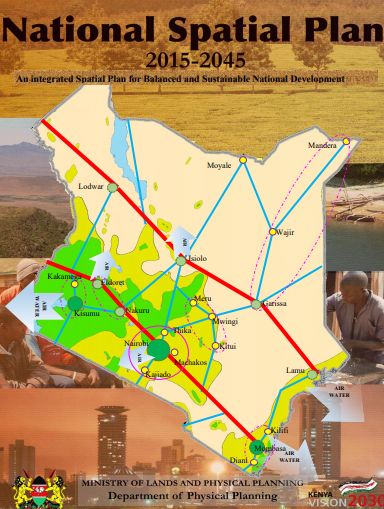Resource information
This National Spatial Plan is the first of its kind in the history of Kenya. The Plan is a strategic vision that defines the general trend and direction of spatial development for the country, covering the entire forty seven counties and the Exclusive Economic Zone (EEZ). It is a long term Plan spanning a period of thirty (30) years with 10 year periodical reviews. The preparation of the National Spatial Plan is recommended under Kenya Vision 2030 as a flagship project. under the Infrastructure Services section it has been identified as one of the foundations for socio-economic transformation. The purpose of the National Spatial Plan is to provide a national spatial structure that defines how the national space is utilized to ensure optimal and sustainable use of land. This is imperative as it will facilitate the achievement of the land policy principles of efficiency, equity, sustainability and productivity. The Plan is anticipated to promote the attainment of national, social, economic and environmental goals and objectives. Further, the Plan provides strategies and policies to deal with national challenges including urbanization, regional imbalances/inequalities, rural development, environmental degradation, transportation and underutilization of the massive resources available in the country. In Kenya the emphasis has hitherto been on economic planning with little or no regard for spatial/physical planning. This major disconnect has led to uncoordinated and unguided development resulting not only in duplication of efforts but also in resource wastage and unbalanced development. The Plan will thus provide a spatial framework upon which the various sectoral plans and policies will be anchored. The Plan as a broad Physical Planning framework shall provide physical planning policies to support economic and sectoral planning and also guide the preparation of regional, county and local physical development plans. The specific objectives of the National Spatial Plan are:- To create a spatial planning context that enhances economic efficiency and strengthens Kenya‟s global competitiveness. To promote balanced regional development for national integration and cohesion. To optimize utilization of land and natural resources for sustainable development. To create livable and functional Human Settlements in both urban and rural areas. To secure the natural environment for high quality of life. To establish an integrated national transportation network and infrastructure system Further to these objectives, the Plan aims to promote the principles of effective public participation, compact cities which entail delineating urban boundaries, smart and green urban growth to promote health and aesthetics, sustainable development for posterity, livability and efficiency among others. National Spatial Plan, 2015-2045 viii Department of Physical Planning The NSP is organized into two sections. Part 1 (chapters 1, 2 and 3) provides the introduction, the planning context and the country‟s overall national development strategies. Part II (chapters 4 and 5) provides the national spatial policy thrusts and implementation framework for the National Spatial Plan. Chapter 1 chronologically traces the historical perspectives of spatial planning efforts in Kenya. It also outlines the methodological approach; the extensive benchmarking that was carried out in order to draw useful lessons towards enriching the Plan; the broad stakeholder consultations that were held with representations drawn from public, private and Non State Actors; the rationale for preparing NSP; the strategic direction of NSP and its constitutional, legal and policy basis. Chapter 2 takes a sectoral approach to situational analysis of the country‟s spatial planning context. The chapter outlines a detailed review of the country‟s geographical position, population dynamics, economic trends, resource endowment, land use patterns and practices, sector policies and plans as well as the aspirations of Kenyans as expounded in the Constitution. Chapter 3 provides approaches and strategies for spatial growth and development of the country by addressing the inherent potentials and the factors that prevent the country from achieving the intended national goals and objectives. Thematic areas on global impacts, land use, regional balance, urbanization, environment, national transportation and infrastructure have been discussed and respective strategies formulated to address the identified issues. In order to actualize the strategies identified in chapter 3 relevant policies, together with supporting measures, have been formulated in chapter 4. Chapter 4 outlines the policies and measures which are aimed at promoting the achievement of the goals and objectives of NSP. The policies are aimed at enhancing the country‟s competitiveness and economic efficiency, modernizing agriculture, diversifying tourism, supporting industrialization, creating functional and livable human settlements, conserving the environment, integrating the national transport network and providing quality infrastructure and services. The chapter proposes policies and measures which are aimed at leveraging opportunities available in the country and to address identified challenges that have hindered growth and development of the country to the desired level. Further, the chapter establishes the National Spatial Structure for purposes of setting the direction of spatial development of the country to achieve pre-determined national objectives. Chapter 5 outlines the implementation framework for the Plan that will be employed in order to achieve the desired end state. The approaches for implementation include the preparation of spatial plans to integrate and conform to the proposals of NSP, assimilation of NSP policies to the sector plans and programmes, formulation of regulations and standards to guide development and incorporation into the five year Medium Term Plan (MTPs). An implementation matrix and institutional framework have been provided to link the proposed policies to the measures and the actors. The Plan proposes setting up of an Inter-Ministerial Committee to spearhead the process of implementation.

